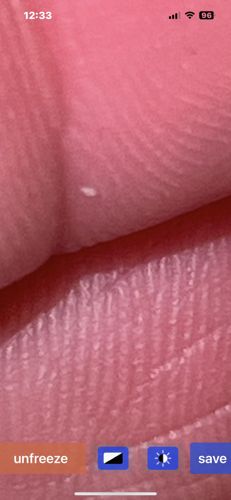Lice egg (nit)
Scientific Name: Pediculus humanus capitis (for head lice)
Order & Family: Psocodea, Pediculidae
Size: Approximately 0.8 mm long, oval-shaped

Natural Habitat
Human hair, typically close to the scalp
Diet & Feeding
Lice eggs themselves do not feed. Nymphs (young lice) and adult lice feed exclusively on human blood.
Behavior Patterns
Nits are laid by adult female lice and are cemented firmly to individual hair shafts. They typically hatch within 7-10 days, after which they are called nymphs. The empty egg case remains attached to the hair. They do not move.
Risks & Benefits
Potential risks: Nits indicate an infestation of lice, which can cause intense itching, skin irritation, and secondary bacterial infections from scratching. Lice infestations are generally considered a nuisance and are primarily a public health concern due to their transmissibility. There are no known benefits.
Identified on: 10/26/2025